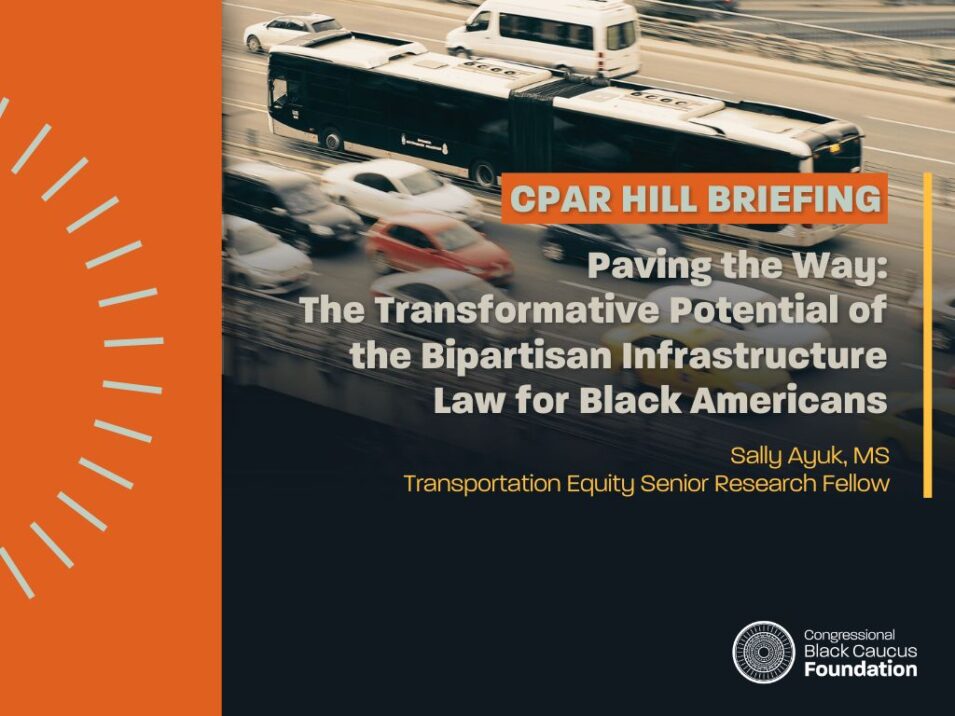By Sally Ayuk, MS, Transportation Equity Senior Research Fellow, Center for Policy and Research, CBCF
Decades of racial segregation, driven by discriminatory zoning regulations, have led to extended commute times for Black Americans. The economic impact of redlining and housing restrictions has made it difficult for Black communities to accumulate wealth and heightened their susceptibility to displacement through gentrification. As the gap in housing costs continues to widen, a growing number of Black Americans have been forced to move further away from their workplaces. As Black Americans navigate racial segregation and economic displacement, one piece of legislation stands as a beacon of hope. Signed into law by President Joe Biden in 2021, the Infrastructure Investment and Jobs Act (IIJA), also known as the Bipartisan Infrastructure Law (BIL), represents a historic commitment of $1.2 trillion for transportation and infrastructure spending, with $550 billion of that going toward new investments and programs. It has the power to address transportation inequalities and pave the way for transformative change, but only if there is a concerted effort to invest in accessible and sustainable infrastructure, prioritize emerging transportation initiatives, and actively engage marginalized communities in the decision-making processes.
Responding to historical injustices, the IIJA holds the potential to rectify systemic disparities that continue to plague Black communities. The IIJA draws inspiration from successful pilot programs like Birmingham On-Demand in Birmingham, AL and Groove On-Demand in Memphis, TN, which provide on-demand rides to underserved areas. These programs prioritize inclusivity, with affordable fares and wheelchair accessibility, and offer affordable access to jobs, businesses, and medical services. Moreover, they illustrate how microtransit – IT-enabled private multi-passenger transportation with dynamic routes and common pickup/drop-off points – can offer affordable and accessible rides that significantly improve job accessibility and enhance service hours. In Detroit, MI and St. Louis, MS, on-demand microtransit services address first/last mile connectivity gaps, making transit networks more efficient and accessible to Black communities. Furthermore, micromobility devices – compact, slow-moving transportation powered by humans or electricity – like electric bikes and scooters, can reshape urban mobility. Collaborations between First Transit and Lyft in Portland, OR and RideKC in Kansas City, KS emphasize the transformative potential of shared micromobility systems, providing a range of options that include traditional pedal bikes, electric-assist bikes, and scooters, along with features such as battery monitoring, retrieval, and rebalancing bike inventory.
But we cannot let this moment slip away. Instead, we must harness the power of the IIJA to maximize positive change.
- Lawmakers, transit agencies, and government officials must spearhead the comprehensive expansion of microtransit and micromobility pilot programs that target underserved areas and communities for improved last-mile connectivity at federal, state, and local levels. Utilizing infrastructure funding from the IIJA’s Strengthening Mobility and Revolutionizing Transportation (SMART) Grants and Pilot Program for Enhanced Mobility, dedicated lanes, and safe pathways should be established for micromobility solutions, such as electric scooters and bicycles. Partnerships between private companies and public transit agencies ought be fostered to ensure sustainable implementation.
- Legislative bodies and local government agencies should play a pivotal role in promoting the efficient integration of Mobility as a Service (MaaS) – a marketplace facilitating ride booking, real-time information viewing, and seamless payment – prioritizing affordability and accessibility, particularly within Black communities. Leveraging the University Transportation Centers (UTC) Program, supported by a $500 million fund, will contribute to advancements in transportation research and technology. This program should be utilized to align MaaS initiatives with equity-focused objectives outlined in the IIJA, facilitating progress and innovation in transportation technology.
- Local authorities, transit agencies, and community leaders must coordinate to address first/last mile challenges in Black neighborhoods. Implementing resident awareness programs will enhance understanding and acceptance of microtransit, micromobility, and MaaS solutions. Stakeholders should actively seek and incorporate feedback from community members to tailor services according to local preferences and needs.
- Government agencies and advocacy groups must champion digital inclusion initiatives to ensure effective access to MaaS platforms. Leveraging the Broadband Equity, Access, and Deployment Program, the Affordable Connectivity Program, and the State Digital Equity Capacity Grant will specifically target diverse populations, including aging individuals, incarcerated individuals, veterans, people with disabilities, those with language barriers, and rural residents, particularly the 11.3% unbanked and 24.7% underbanked Black individuals.
- Transportation planners, city officials, and transportation agencies must take responsibility for planning for diverse transportation options with a focus on universal design to cater to disabled and aging populations. Utilizing the Enhanced Mobility of Seniors and Individuals with Disabilities program can support initiatives in Black communities, ensuring that transportation options are accessible and affordable.
- Government agencies and environmental organizations must lead initiatives that advance sustainability in public transportation, specifically in Black communities. Utilizing the Research, Development, Demonstration, and Deployment Projects, tailored efforts can be made to improve the environmental sustainability, safety, and efficiency of public transportation. Promoting shared mobility initiatives to mitigate greenhouse gas emissions is key to achieving long-term sustainability goals.
In addressing transportation inequities, elected officials, community activists, and urban planners must seize the moment. Spearheading the expansion of microtransit and micromobility, integrating Mobility as a Service, and championing digital inclusion and sustainable public transportation initiatives are crucial to leveraging IIJA’s funding. This calls for swift, coordinated efforts to foster partnerships, engage communities, and prioritize affordability, accessibility, and sustainability. Only then can we pave the way for a more equitable and interconnected urban landscape, where transportation catalyzes social and economic empowerment, breaking down barriers and ensuring that every individual, regardless of their race, has seamless access to opportunities and services.
Click here to read Sally Ayuk’s policy brief, “MaaS Revolution: Mobility Beyond the First/Last Mile in Black Communities.”
